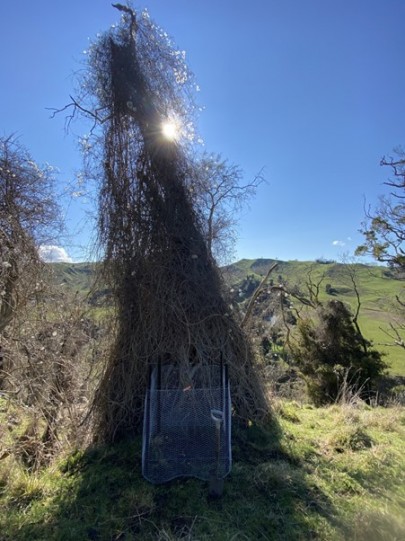The Old Man’s Beard Mite Has Finally Landed

The old man’s beard mite release site in Rangitikei
The old man’s beard mite is extremely difficult to rear under laboratory conditions, so host range testing was eventually conducted by acarologist, Dr Biljana Vidovic (University of Belgrade) in its native range of Serbia. Then, after receiving approval for release from the Environment Protection Authority (EPA) in October 2018, a starter colony of the mite was hand-delivered to Lincoln by Biljana in July 2019. Once in containment, the microscopic mites were individually collected on pinheads under a microscope and transferred onto fresh old man’s beard plants, which were later moved to outdoor greenhouses after MPI approved the removal of the mites from containment. Eighteen months later, with improved mass-rearing techniques and much patience and perseverance, we were able to mass-produce enough mites for releases across the country this spring.
“Since the mites are microscopic, confirming their presence on old man’s beard plants is not always easy,’ explained entomology technician, Arnaud Cartier. “Buds need to be dissected under the microscope to view the mites, and the damage is not very obvious or is quickly hidden by new plant growth when they are at low densities,” he added. Even though the old man’s beard mite is closely related to the broom gall mite (Aceria genistae) which produces impressive galls, feeding by the old man’s beard mites stunts the growth of stem and leaf buds, but doesn’t induce obvious gall formation. Deformed, curled and atrophied leaflets are the first sign of feeding by the mites, and at high densities, plant growth is significantly reduced. Arnaud regularly dissects a random selection of plant material from the mass-rearing greenhouses to confirm the plants are well infested and that the mite population is increasing.
The old man’s beard mite is the fourth biocontrol agent to be released against this very serious environmental weed, and it has not been released anywhere else in the world. The first two agents released, a leaf-mining fly (Phytomiza vitalbae) and a fungus (Phoma clematidina), have been unsuccessful, and the third agent, a sawfly (Monophadnus spinolae), has recently established at a new site in the Waipara District in the South Island. This was following a re-release in 2019 after its importation from Serbia, and this new population is now being closely monitored for growth and impact.
Aceria mites can be very damaging to their host plants and have the advantage of being able to disperse themselves over long distances by floating in the air, much like aerial plankton. Evidence of this was found close to home when a population of the mite was discovered on an experimental patch of old man’s beard (Clematis vitalba) growing on our Lincoln campus, at least 100 m from the mass-rearing greenhouses. This self-established population provides an excellent opportunity to monitor the impact and spread of the mite. Even better, the finding confirms that once established in an area, no effort to intentionally spread the mites around will be required.
Following the first release of the old man’s beard mite in Rangitikei, more releases were conducted by several regional councils in both the North and South Islands, totalling 14 releases altogether within a few weeks. The most recent, conducted by Environment Canterbury (EC) and Manaaki Whenua – Landcare Research (MWLR) staff in Timaru was an occasion to celebrate, and one that was 10 years coming.
Funding
This project was funded by the National Biocontrol Collective (NBC) and is now jointly funded by the NBC and the Ministry for Primary Industries’ Sustainable Food and Fibre Futures (grant #20095).
Key contact

